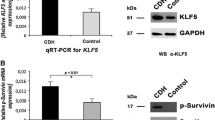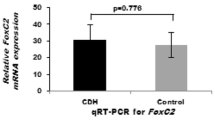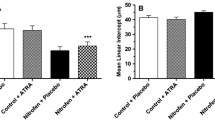Abstract
Purpose
The high mortality in congenital diaphragmatic hernia (CDH) is mainly attributed to pulmonary hypoplasia. Recent studies suggest that retinoid signaling pathway (RSP) is inhibited in the nitrofen-induced hypoplastic lung. The insulin-like growth factor (IGF) system plays a crucial role in fetal lung development by interaction of IGFBP-3 and IGFBP-5 with RSP. We hypothesized that pulmonary IGFBP-3 and IGFBP-5 gene expression levels are downregulated in the nitrofen-induced pulmonary hypoplasia.
Methods
Pregnant rats were exposed to either olive oil or 100 mg nitrofen on day 9.5 (D9.5) of gestation. Fetal lungs were harvested on D18 and D21 and divided into control and nitrofen groups. IGFBP-3 and IGFBP-5 pulmonary gene and protein expression were determined using real-time RT–PCR and immunohistochemistry.
Results
Relative levels of IGFBP-3 mRNA were significantly decreased in the nitrofen group (8.00 ± 14.44) in D21 compared to controls (14.81 ± 16.11; p < 0.05). Expression levels of IGFBP-5 mRNA were also significantly decreased in nitrofen group (10.66 ± 4.83) on D18 compared to controls (17.92 ± 4.77). Immunohistochemistry showed decreased IGFBP-3 expression on D21 and decreased IGFBP-5 immunoreactivity on D18 in hypoplastic lungs compared to controls.
Conclusion
Downregulation of IGFBP-3 and IGFBP-5 gene expression may cause pulmonary hypoplasia in the nitrofen-induced CDH model by interfering with retinoid signaling pathway.
Similar content being viewed by others
Avoid common mistakes on your manuscript.
Introduction
Congenital diaphragmatic hernia (CDH) is a common congenital malformation with an incidence of 1 in 2,500 newborns [1]. Despite recent advances in prenatal diagnosis, resuscitation and intensive care, mortality and morbidity in CDH still remains high [2, 3]. This high mortality is mainly due to severe pulmonary hypoplasia associated with CDH [4].
Due to its phenotypic similarity to human CDH, the nitrofen-induced CDH rodent model has been extensively used to investigate the pathogenesis of CDH [5, 6]. Maternal exposure of nitrofen, both in rats and in mice 50 models, during a specific period in gestation results in 100% lung hypoplasia and a high rate (40–80%) of CDH in the offspring [7, 8]. One hypothesis put forward to explain the cause of lung hypoplasia associated with CDH is the retinoic acid hypothesis. Retinoids are the family of molecules derived from vitamin A (VitA). There is compelling evidence that retinoid acid (RA), a biologically active derivative of VitA, functions as an important signal for growth and differentiation during all stages of lung development [9]. Once retinoic acid (RA) has been synthesized in the cell, it enters the nucleus and establishes or changes the pattern of gene activity by binding to ligand-activated nuclear transcription factors. There are two classes of these transcription factors: retinoic acid receptors (RAR) and retinoid X receptors (RXR). The RAR–RXR heterodimers are the functional units in transducing the retinoid signaling at the gene level [10–12]. Abnormalities in RSP and its downstream targets have been reported to lead to the development of CDH and associated pulmonary hypoplasia [13]. However, the exact mechanism by which nitrofen acts in the RSP remains unclear.
The insulin-like growth factor (IGF) system, consisting of the insulin-like growth factor I and IGF-II and their receptors (insulin-like growth factor receptor type 1 (IGF-1R), IGF-2R and insulin-receptor (IR)), is known to play a key role in fetal lung development. IGFs in serum and extracellular fluids are complexed with a variety of insulin-like growth factor binding proteins (IGFBPs), characterized by its ability to bind IGFs. Six IGFBPs (IGFBP-1 to -6) bind IGFs with high affinity and are well characterized [14, 15]. IGFBP-2 to -5 are described in the fetal lung [16]. All IGFBPs inhibit IGF action by sequestering IGFs, whereas IGFBP-3 and IGFBP-5 also potentiate IGFs action. Although IGFBP-3 and IGFBP-5 are known to modulate cell growth by IGFs-dependent extracellular actions, they also have IGFs independent intracellular actions via signaling through cell surface receptors of IGFBPs [17]. In the developing rat lung, IGFBP-3 and IGFBP-5 are not only expressed in the proximal airway epithelium, but also in the interstitial and perivascular mesenchyme with increasing abundance as gestation progresses [14]. Recently, there is increasing evidence that IGFBP-3 and IGFBP-5 play an important role during fetal lung development [18]. It has been reported that IGFBP-3 and IGFBP-5 interact with RSP through binding to retinoid X receptor alpha (RXR-α) and activate its transcriptional activity [19].
The above studies led us to hypothesize that disturbance of RSP is caused by decreased expression of IGFBP-3 and IGFBP-5 in the nitrofen-induced hypoplastic lung. We, therefore, designed this study to investigate gene and protein expression of IGFBP-3 and IGFBP-5 in the nitrofen-induced hypoplastic lung.
Materials and methods
Animals and drugs
Fetal pulmonary hypoplasia with coexisting diaphragmatic hernia was created by gavaging time dated pregnant Sprague–Dawley rats. Adult rats were mated, and the females were daily checked for plugging. The presence of spermatozoids in the vaginal smear was considered as a proof of pregnancy; the day of observation was determined as gestational day 0; term was considered as day 22. Pregnant female rats were than randomly divided into two groups. At day 9 of gestation (D9), animals in the experimental group received 100 mg of 2,4-dichloro-4′diphenylether (nitrofen) (WAKO Chemicals, Osaka, Japan) dissolved in 1 ml of olive oil via gastric tube under short anesthesia. In control animals, the same dose of olive oil was given without nitrofen. Fetuses were harvested by cesarean section on D18 and D21. Left lungs of the fetus were dissected after thoracotomy under microscopic inspection. Fetus exposed to nitrofen were defined as the CDH group (n = 8 at each time point), whereas the control group (n = 8 at each time point) consisted of animals that received only vehicle. The Department of Health and Children approved the protocol of these animal experiments (ref. B100/4142) under the Cruelty to Animals Act, 1876; as amended by European Communities Regulations 2002 and 2005, and all animals were treated according to the current guidelines of animal care.
Isolation of mRNA, cDNA synthesis and real-time reverse transcription polymerase chain reaction (RT–PCR)
The peripheral region of the left lung of each fetus was suspended in TRIzol® Reagent (Invitrogen, USA) immediately after dissection, quick frozen in liquid nitrogen and stored at −20°C. After thawing frozen samples, they were homogenized using a pellet pestle and total mRNA of the lung tissue was isolated from the TRIzol® suspension using the acid guanidinium-thiocyanate–phenol–chloroform extraction method. Total mRNA quantification was performed spectrophotometrically (ND-1000 UV–Vis® Spectrophotometer, NanoDrop, USA). Synthesis of cDNA was performed using Transcript High Fidelity cDNA Synthesis Kit® (Roche Diagnostics, Germany) according to the manufacturer’s protocol. Reverse transcription was carried out at 85°C for 30 min (denaturation), at 44°C for 60 min (annealing), and at 92°C for 10 min (RT-inactivation) according to the manufacturer’s protocol. Real-time polymerase chain reaction was performed using LightCycler® 480 SYBR Green I Master (Roche Diagnostics, Germany) according to the manufacturer’s protocol. The specific primer set used in this study is listed (Table 1). After initialization step at 95°C for 5 min, 45 cycles of amplification were carried out (denaturation at 95°C for 10 s, annealing at 60°C for 15 s, and extension at 72°C for 10 s in each cycle). Relative levels of gene expression were measured by Light Cycler® 480 (Roche Diagnostics, Germany) according to the manufacturer’s instruction. The mRNA expression levels of IGFBP-3 and IGFBP-5 were normalized to β-actin mRNA expression levels in each sample.
Immunohistochemistry
The paraffin-embedded left lungs were sectioned at a thickness of 7 μm, and the sections were deparaffined with xylene and then rehydrated through ethanol and distilled water. Tissue sections were immersed in Dako Target Retrieval Solution® (DakoCytomation, California, USA) heated for 10 min at 121°C followed by incubation in Peroxidase Block® (En Vision+System-HRP (DAB), DakoCytomation, California, USA) for 30 min to block endogenous peroxydase activity. Sections were incubated overnight at 4°C with a 1:100 dilution of rabbit polyclonal antibodies against IGFBP-3 and IGFBP-5 (LOT sc-7953, Santa Cruz Biotechnology, USA). Sections were then treated in Labelled Polymer-HRP Anti-Rabbit® (En Vision+System-HRP (DAB) DakoCytomation, California) secondary antibody and then further processed using DAB+Subtrate Buffer® and DAB+Chromogen® (En Vision+System-HRP (DAB), DakoCytomation, California, USA) according to the manufacturer’s instruction. Finally sections were counterstained with aqueous hematoxylin, mounted with aqueous-based Glycergel Mounting Medium® (DakoCytomation, California, USA) and coverslipped.
Statistical analysis
All numbered data are presented as mean ± standard deviation. Differences between two groups at each gestational day were tested by using an unpaired Student’s or Welch’s t-test when the data had normal distribution, or Mann–Whitney’s U test when the data deviated from normal distribution. Statistical significance was accepted at p-values < 0.05.
Results
Relative mRNA expression levels of IGFBP-3 and IGFBP-5 in fetal rat lungs
On D21 relative levels of IGFBP-3 mRNA were significantly decreased in nitrofen group compared to controls (p < 0.05; Table 2). However, there were no significant differences between nitrofen group and controls in the pulmonary IGFBP-3 expression levels on D18.
The expression levels of IGFBP-5 were also significantly decreased on D18 in the nitrofen group compared to controls (p < 0.05). On D21, there were no significant differences between nitrofen and controls in the gene expression levels of IGFBP-5.
Protein expression of IGFBP-3 and IGFBP-5 in fetal rat lungs
To determine whether the decreased amounts of IGFBP-3 and IGFBP-5 transcripts were reflected in the immunoreactivity of the proteins themselves in the nitrofen-induced hypoplastic lung, immunohistochemical studies were performed (Fig. 1).
IGFBP-3 and IGFBP-5 immunohistochemistry. IGFBP-3 protein expression at D18 control (a) and CDH (b) showing no difference in immunoreactivity. At D21, strong IGFBP-3 staining is seen in control lungs (c), whereas CDH lungs (d) show diminished overall expression. At D18, strong expression of IGFBP-5 staining is shown in control lungs (e), whereas diminished IGFBP-5 expression is shown in CDH lungs (f). IGFBP-5 expression at D21 control (g) and CDH (h) showing no differences in immunoreactivity
In D18 control and CDH lungs, there was diffuse expression of IGFBP-3 protein that appeared to be localized to both the proximal alveolar epithelium and to the mesenchymal compartments of the lung with no differences in immunoreactivity (Fig. 1a, b). In D21 lungs, the overall immunoreactivity of IGFBP-3 was diminished in CDH lungs (Fig. 1d), whereas strong overall IGFBP-3 protein expression was seen in control lungs (Fig. 1c).
On D18 protein expression of IGFBP-5 was also localized to the proximal alveolar epithelium and the mesenchymal compartments, showing a decrease in the immunoreactivity of IGFBP-5 in CDH lungs (Fig. 1f). However, in D18 control lungs, strong expression of IGFBP-5 was seen in both compartments (Fig. 1e). On D21 no difference was observed in the immunoreactivity of IGFBP-5 between control and nitrofen group (Fig. 1g, h).
Discussion
Despite newer therapies, such as extracorporeal membrane oxygenation, inhaled nitric oxide and high frequency ventilation, the mortality and morbidity in infants with severe CDH still remains high [2, 3]. Pulmonary hypoplasia, characterized by immaturity and small lung size, is considered to be one of the principle contributors for its unfavorable prognosis. VitA and its derivates, retinoids, are essential for fetal lung development [9]. Recently, the nitrofen-induced CDH rodent model has been focused on the RSP to elucidate the pathogenesis of pulmonary hypoplasia in CDH. A study using genetically engineered mice demonstrated a pronounced suppression of the retinoid response element by nitrofen [20]. Using an in vitro assay, it has been demonstrated that nitrofen inhibits RALDH2, the enzyme catalyzing the final step in RA production [21]. Previous studies from our laboratory have reported that retinol storage and the expression of the genes involved in the RSP are altered in the nitrofen-induced hypoplastic lung [22]. Recently, we have also demonstrated that RA treatment can rescue nitrofen-induced lung hypoplasia both in vivo and in the lung explants [23]. Collectively, these data strongly imply that retinoids are candidates involved in the pathogenesis of hypoplastic lung associated with CDH and that nitrofen may act as a teratogen by interfering with RSP.
IGFBPs are a family of proteins that bind IGFs with high affinity and specificity, which modulate IGF action by inhibiting or potentiating IGF binding to the IGF receptor [17]. Although IGFBP-3 and IGFBP-5 are known to modulate cell growth by reversibly sequestering extracellular IGFs, several reports have suggested, that IGFBP-3 and IGFBP-5 have important IGF-independent effects on cell growth by modulating gene transcription [15]. It has been reported that IGFBP-3 and IGFBP-5 can interact with RXR-α, a nuclear transcription factor in RSP, in IGFs independent manner [18]. Internalized IGFBP-3 and IGFBP-5 binds to importin-β and translocates through the nuclear pore complex (NPC) to the nucleus, where it enhances RXR and subsequent transcription activity of RXRE-dependent genes [15]. Because RXR-α is also expressed in fetal lung [24] pulmonary IGFBP-3 and IGFBP-5 may modulate lung growth by stimulating RXR-α dependent transcription activity.
In the present study, we observed significant downregulation of IGFBP-3 gene expression in the nitrofen-induced hypoplastic lungs on D21 compared to controls and we also observed significant decreased IGFBP-5 mRNA gene expression in hypoplastic lungs on D18 compared to controls. Immunohistochemical studies confirmed decreased IGFBP-3 immunoreactivity in the proximal alveolar epithelial cells as well as in the mesenchymal cells on D21 in the nitrofen-induced hypoplastic lungs and also decreased intensity of IGFBP-5 protein expression with similar distribution to IGFBP-3 on D18 in hypoplastic lungs compared to controls. IGFBP-3 and IGFBP-5 gene expression in the lung has been reported to vary with the gestational age, with the IGFBP-3 mRNA expression seen only at later gestational ages in in situ hybridization analyses [16].
We provide evidence, for the first time, that IGFBP-3 and IGFBP-5 gene and protein expression are downregulated in the nitrofen-induced hypoplastic lungs during later stages of lung development. Our findings suggest that nitrofen may induce pulmonary hypoplasia associated with CDH due to downregulation of IGFBP-3 and IGFBP-5 gene expression during mid-to-late lung development by interfering with RXR-α mediated RSP. Further investigation of cross talk between IGF system and RSP in the nitrofen-induced hypoplastic lung is required and should provide insights into the pathogenesis of lung hypoplasia associated with CDH.
References
Torfs C, Curry C, Bateson TF et al (1992) A population-based study of congenital diaphragmatic hernia. Teratology 46:555–565. doi:10.1002/tera.1420460605
Bohn D (2002) Congenital diaphragmatic hernia. Am J Respir Crit Care Med 166:911
Puri P (1994) Congenital diaphragmatic hernia. Curr Prob Surg 31:787–846
Dillon P, Cilley R, Mauger D et al (2004) The relationship of pulmonary artery pressure and survival in congenital diaphragmatic hernia. J Pediatr Surg 39:307–312
Iritani I (1984) Experimental study on embryogenesis of congenital diaphragmatic hernia. Anat Embryol 169:133–139. doi:10.1007/BF00174435
Tenbrick R, Tibboel D, Gaillard J et al (1990) Experimentally induced congenital diaphragmatic hernia in rats. J Pediatr Surg 25:426–429
Noble B, Babiuk R, Clugston R (2007) Mechanism of congenital diaphragmatic hernia-inducing teratogen nitrofen. Am J Physiol Lung Cell Mol Physiol 293:L1079. doi:10.1152/ajplung.00286.20071040-0605/07
Kluth D, Kangah R, Reich P et al (1990) Nitrofen induced diaphragmatic hernia in rats: an animal model. J Pediatr Surg 25:850–854
Zachman RD (1995) Role of vitamin A in lung development. J Nutr 125:1634S–1638S
Smith S, Dickman E, Power S et al (1998) Retinoids and their receptors in vertebrate embryogenesis. J Nutr 128:467S–470S
Zile M (2001) Function of vitamin A in vertebrate embryonic development. J Nutr 128:455S–485S
Zile M (1998) Vitamin A and embryonic development: an overview. J Nutr 128:455S–458S
Greer J, Babiuk R, Thebaud B (2003) Etiology of congenital diaphragmatic hernia: the retinoid hypothesis. Pediatr Res 53:726–730. doi:10.1203/01.PDR.0000062660.12769.E6
Price WA, Stiles AD (2000) The insulin-like growth factor system and lung. In: Mendelson CR (ed) Endocrinology of the lung. Humana Press Inc, Totowa, pp 201–208
Ricort J-M (2004) Insulin-like growth factor binding protein (IGFBP) signaling. Growth Horm IGF Res 14:277–286. doi:10.1016/j.ghir.2004.02.002
Retsch-Bogart GZ, Moats-Staats BM, Howard K et al (1996) Cellular localization of messenger RNAs for insulin-like growth factors (IGFs), their receptors and binding proteins during fetal rat lung development. Am J Respir Cell Mol Biol 14:61–69
Pavelic J, Matijevic T, Knezevic J (2007) Biological & physiological aspects of action of insulin-like growth factor peptide family. Indian J Med Res 125:511–522
Liu B, Lee H-Y, Weinzimmer SA et al (2000) Direct functional interaction between insulin like growth factor binding protein-3 and retinoid X receptor alpha regulate transcriptional signaling and apoptosis. J Biol Chem 275:33607–33613. doi:10.1074/jbc.M002547200
Schedlich LJ, Young TF, Firth SM et al (1998) Insulin-like growth factor binding protein (IGFBP)-3 and IGFBP-5 share a common nuclear transport pathway in T47D human breast carcinoma cells. J Biol Chem 273:18347–18352
Chen M, MacGowan A, Ward S et al (2003) The activation of the retinoic acid response element is inhibited in an animal model of congenital diaphragmatic hernia. Biol Neonate 83:157–161. doi:10.1159/000068932
Mey J, Babiuk R, Clugston R et al (2003) Retinal dehydrogenase-2 is inhibited by compounds that induce congenital diaphragmatic hernias in rodents. Am J Pathol 162:673–679
Nakazawa N, Montedonico S, Takayasu H et al (2007) Disturbance of retinol transportation causes nitrofen induced hypoplastic lung. J Pediatr Surg 42:345–349. doi:10.1016/j.jpedsurg.2006.10.028
Montedonico S, Nakazawa N, Puri P (2006) Retinoic acid rescues lung hypoplasia in nitrofen-induced hypoplastic foetal rat lung explants. Pediatr Surg Int 22:2–8. doi:10.1007/s00383-005-1571-x
Kimura Y, Suzuki T, Kaneko C et al (2002) Retinoid receptors in the developing human lung. Clin Sci 103:613–621
Author information
Authors and Affiliations
Corresponding author
Rights and permissions
About this article
Cite this article
Ruttenstock, E., Doi, T., Dingemann, J. et al. Downregulation of insulin-like growth factor binding protein 3 and 5 in nitrofen-induced pulmonary hypoplasia. Pediatr Surg Int 26, 59–63 (2010). https://doi.org/10.1007/s00383-009-2509-5
Published:
Issue Date:
DOI: https://doi.org/10.1007/s00383-009-2509-5





